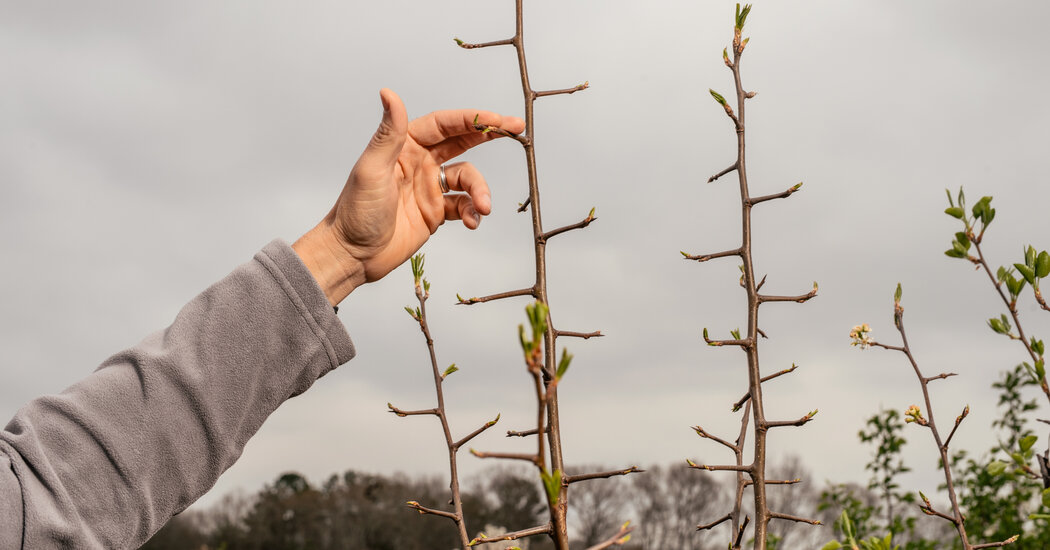CLEMSON, S.C. — Within the distance, beside a brick home in a tidy subdivision, the bushes rose above a wood fence, displaying off all that had made the Bradford pear so alluring: They had been towering and sturdy and, within the early spring, had white flowers that turned their limbs into excellent clouds of cotton.
However when David Coyle, a professor of forest well being at Clemson College, pulled over in his pickup, he might see the monster these bushes had spawned: a forbidding jungle that had consumed an open lot close by, the place the identical white flowers had been blooming uncontrollably in a thicket of tangled branches studded with thorns.
“When this tree will get rising someplace, it doesn’t take lengthy to take over the entire thing,” Professor Coyle, an invasive species knowledgeable, mentioned. “It simply wipes every little thing out beneath it.”
Starting within the Nineteen Sixties, as suburbs sprouted throughout the South, clearing land for labyrinths of cul-de-sacs and two-car garages, Bradford pears had been the bushes of selection. They had been simply out there, might thrive in nearly any soil and had an interesting form with mahogany-red leaves that lingered deep into the autumn and flowers that appeared early within the spring.
The bushes’ recognition soared throughout a transformational time, as tens of millions of People moved in pursuit of the consolation and order that suburban neighborhoods had been designed to supply. “Few bushes possess each desired attribute,” the gardening pages of The New York Occasions declared in 1964, “however the Bradford decorative pear comes unusually near the best.”
But for all that promise, the bushes wound up an unwieldy menace, one which has vexed botanists, owners, farmers, conservationists, utility corporations and authorities officers in a rising swath of the nation throughout the East Coast and reaching into Texas and the Midwest.
In South Carolina, the struggle has intensified. The state is within the means of barring the sale and commerce of the bushes. Professor Coyle, who tracks crops and bugs which have intruded into South Carolina and tries to restrict their injury, has organized “bounty” packages, the place individuals who herald proof of a slain tree get a local substitute in return.
The downsides of the Bradford pear had been refined at first. Its white flowers, as fairly as they had been, emitted a fetid odor that smells almost fishy. However because the bushes aged, increasingly more negatives emerged. They’d a poor department construction, leaving them vulnerable to snapping and toppling in storms, sending limbs onto energy strains, sidewalks and the roofs of houses they had been imagined to beautify.
However probably the most far-reaching consequence emerged as pear bushes started colonizing open fields, farmland, river banks and ditches, and rising between the pines alongside the highways from Georgia up by the Carolinas, edging out native species and upending ecosystems. The bushes develop quickly, climbing to as excessive as 15 ft inside a decade. (They’ll in the end attain 50 ft excessive and 30 ft huge.)
“You’ll be able to’t miss it,” mentioned Tim Rogers, the overall supervisor of an organization that sells crops and provides to landscaping corporations. “It’s all over the place.”
The Bradford pear is a cultivar of the callery pear, that means it’s a selection produced by selective breeding — on this case, devising a tree that didn’t have the thorns of another varieties and was unbothered by pests.
However just like the acquainted plot of science-fiction tales, the creation that appeared too good to be true was, certainly, too good to be true. The Bradford pear had been billed as sterile, however that was not precisely proper. Two Bradford pears can’t reproduce, scientists mentioned, however they will cross-pollinate with different pear bushes, and their seeds are unfold broadly by birds.
It’s the ensuing callery pear development that alarms scientists: These bushes unfold quickly, have thorns which are three or 4 inches lengthy and cluster shut collectively, disrupting life for bugs and different crops. “It’s a meals desert for a chook,” Professor Coyle mentioned, noting that the bushes don’t maintain caterpillars and different herbivorous bugs. “There’s nothing to eat there.”
The callery pear, which is native to East Asia, was originally brought to the United States by federal researchers who sought a species that resisted blight and might be bred with the European pear to bolster fruit manufacturing. However scientists acknowledged its potential as a decorative tree, spurring the event of the Bradford pear.
The tree’s recognition was largely concentrated within the Southeast and alongside the Mid-Atlantic coast. Nevertheless it has been planted throughout the nation, dotting lawns and the entrances to subdivisions and buying malls.
“There are some locations the place I’ve seen complete campuses planted with this one tree,” mentioned Nina Bassuk, a professor and director on the City Horticulture Institute at Cornell College. “In case you’re there in April, it’s simply this sea of white.” However then, she added, “Bradfords turned an issue.” Ageing bushes had been falling aside, she mentioned, and “we began noticing them in locations the place they weren’t planted.”
Officers in South Carolina added the Bradford pear to its State Plant Pest Listing this 12 months, and initiated a ban that goes into impact on Oct. 1, 2024. Ohio is the one different state that has taken similar measures with the callery pear, with a ban starting in 2023. Delaware enacted more sweeping legislation this 12 months that bars the promoting, importing or planting of any invasive species.
In different states, efforts to ban the bushes have confronted resistance from the plant business, researchers mentioned, given how a lot nurseries depend on their hardiness in utilizing it as rootstock.
However in South Carolina, business leaders mentioned that researchers satisfied them that alternate options had been out there. The choice was additionally simpler as a result of, as a landscaping tree, Bradford pears had plummeted in recognition. “That plant has been on a decline for a very very long time,” mentioned Mr. Rogers, who can be the president-elect of S.C. Inexperienced, an business affiliation.
Previously, clients had sought out the bushes, whilst their troubles turned extra broadly understood. “I’d name them a obligatory evil by way of stock,” Mr. Rogers mentioned. However these days are long gone. “It’s not even in our catalog,” he added.
Scientists and officers mentioned that the general public is growing a extra subtle understanding of the results that landscaping selections can have. They level to the Southwest, the place drought-friendly designs have grown in recognition as water has turn out to be extra scarce.
Within the South, many had been already aware of the specter of invasive species because the area has grappled with crops like privet and, most of all, kudzu, the Asian vine described because the plant that ate the South, blanketing a lot of the panorama and breeding myths about the pace and attain of its development.
Nonetheless, state officers and owners are left to cope with the numerous Bradford pears planted in years previous. One Saturday final month, Professor Coyle traveled to Columbia, the state capital, for the newest of the bounty exchanges that he has organized throughout South Carolina.
A flatbed trailer was loaded with scores of potted native bushes: Shumard oak, yellow poplar, persimmon, Japanese purple cedar, candy bay magnolia. Professor Coyle famous the trailer was parked within the shade of a Chinese language pistache, one other nonnative plant.
The handfuls of people that signed up might accumulate one of many native bushes in alternate for proof of a vanquished pear tree. (A selfie posing with the tree sufficed.)
Valerie Krupp had printed out pictures of the Bradford pears that had toppled over in her yard, ruining her gutters and clipping the nook of her home. “I want I had taken them out quite a bit sooner,” she mentioned. She picked out a reside oak, a Shumard oak and a magnolia, and he or she mentioned she seemed ahead to their rising and filling the void left by the pear bushes. “I loved the shade,” she mentioned.
As Rick Dorn loaded his replacements into the mattress of his truck, he described the torment of coping with an infestation of callery pear. The thorns is perhaps the worst half. “They’ll punch a gap right into a tire,” he mentioned.
His household owns a diffusion of about 60 acres close to Irmo, a suburb of Columbia. The land has been overtaken by the bushes, which, he famous, popped up across the similar time because the subdivisions that now encompass the property.
Professor Coyle believed that his efforts have notched some progress: A whole bunch of bushes have been swapped by the bounty packages, and he noticed the ban as a significant step. Nonetheless, they had been incremental advances in opposition to a drive of nature.
“I do know this isn’t going to be a fast repair,” Professor Coyle mentioned. “If we’re being sincere, I’ll be engaged on callery pear for my complete profession.”
However incremental progress was higher than none in any respect.
“Little by little, man,” he mentioned. “Little by little.”

